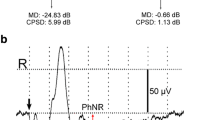Summary
1. Increment thresholds of the isolated frog's retina have been measured by superimposing blue-green test stimuli (502 mμ) upon a red conditioning field (623 mμ). The whole retina was illuminated by both the test and the background field. A constant small response in the electro-retinogram (e.r.g.) was used as threshold criterion.
2. Using the same red background illumination (623 mμ) the Purkinje-shift of the preparation has been studied with the aid of two monochromatic test stimuli of wavelengths 502 and 578 mμ respectively.
3. Increment thresholds and Purkinje-shift as well as configurational changes in the e.r.g. indicate the failure of rod function if the background field exceeds a certain value of retinal irradiance (0.11 erg/sec·cm2; λ=502 mμ) which is comparable to the figure found at the beginning of rod saturation in the human retina.
Zusammenfassung
1. Zuwachsschwellen der isolierten Froschnetzhaut wurden mit blaugrünen Testreizen (502 mμ) bei Adaptation an rotes Dauerlicht (623 mμ) gemessen (Methode der konstanten Antwort im Elektroretinogramm).
2. Die Purkinje-Verschiebung wurde mit zwei Testreizen unterschiedlicher Wellenlänge (502 und 578 mμ) bei Adaptation an das gleiche rote Dauerlicht (623 mμ) gemessen.
3. Zuwachsschwelle und Purkinje-Verschiebung zeigen ebenso wie die Form der Elektroretinogramme, daß das skotopische System der Präparation seine Funktion einstellt, wenn das Adaptationslicht eine Bestrahlungsstärke von 0,11 erg/sec·cm2 (λ=502 mμ) überschreitet. Bei etwa gleicher retinaler Bestrahlungsstärke beginnt die Stäbchensättigung der menschlichen Retina.
Similar content being viewed by others
Literatur
Aguilar, M., and W. S. Stiles: Saturation of the rod mechanism of the retina at high levels of stimulation. Optica Acta 1, 59–65 (1954).
Baumann, Ch.: Die absolute Schwelle der isolierten Froschnetzhaut. Pflügers Arch. ges. Physiol. 280, 81–88 (1964).
— Sehpurpurbleichung und Stäbchenfunktion in der isolierten Froschnetzhaut. I. Die Sehpurpurbleichung. Pflügers Arch. ges. Physiol. 298, 44–60 (1967a).
— Sehpurpurbleichung und Stäbchenfunktion in der isolierten Froschnetzhaut. III. Die Dunkeladaptation des skotopischen Systems nach partieller Sehpurpurbleichung. Pflügers Arch. ges. Physiol. 298, 70–81 (1967b).
— P. Dettmar, R. Hanitzsch u. W. Sickel: Untersuchungen an der umströmten Froschnetzhaut zur Analyse des ERGs. Acta ophthal. (Kbh.), Suppl. 70, 156–163 (1962).
Dartnall, H. J. A.: The visual pigments of the green rods. Vision Res. 7, 1–16 (1967).
Dodt, E., K. Echte u. K. H. Jessen: Elektroretinographische Messung der Unterschiedsschwelle (increment threshold) bei Steigerung der adaptiven Beleuchtung. Ber. dtsch. ophthal. Ges. 63, 319–322 (1961).
Donner, K. O., and T. Reuter: The spectral sensitivity and photopigment of the green rods in the frog's retina. Vision Res. 2, 357–372 (1962).
— The dark-adaptation of single units in the frog's retina and its relation to the regeneration of rhodopsin. Vision Res. 5, 615–632 (1965).
Elenius, V., u. E. Dodt: Dunkeladaptation und Duplizitätslehre. Pflügers Arch. ges. Physiol. 272, 20–21 (1960).
Granit, R.: Colour receptors of the frog's retina. Acta physiol. scand. 3, 137–151 (1942).
Hecht, S., S. Shlaer, and M. H. Pirenne: Energy, quanta and vision. J. gen. Physiol. 25, 819–840 (1942).
Le Grand, Y.: Light, Colour and Vision. New York: John Wiley and Sons, Inc. 1957.
Riggs, L. A.: Dark adaptation in the frog eye as determined by the electrical response of the retina. J. cell. comp. Physiol. 9, 491–510. (1937).
Sickel, W.: Stoffwechsel und Funktion der isolierten Netzhaut. Symposion Neurophysiologie und Psychophysik des visuellen Systems, Freiburg 1960, S. 80–94. Hrsg. R. Jung u. H. Kornhuber. Berlin-Göttingen-Heidelberg: Springer 1961.
Stiles, W. S.: The directional sensitivity of the retina and the spectral sensitivities of the rods and cones. Proc. roy. Soc. B 127, 64–105 (1939).
Weale, R. A.: Limits of human vision. Nature (Lond.) 191, 471–473 (1961).
Author information
Authors and Affiliations
Additional information
Mit Unterstützung durch die Deutsche Forschungsgemeinschaft.
Rights and permissions
About this article
Cite this article
Baumann, C. Sehpurpurbleichung und Stäbchenfunktion in der isolierten Froschnetzhaut. Pflügers Archiv 298, 61–69 (1967). https://doi.org/10.1007/BF00362635
Received:
Issue Date:
DOI: https://doi.org/10.1007/BF00362635




